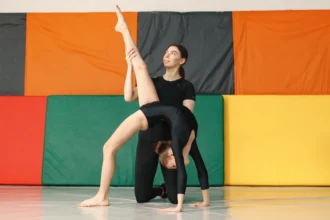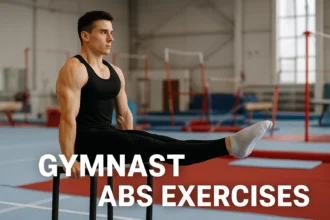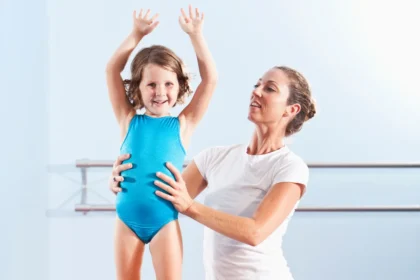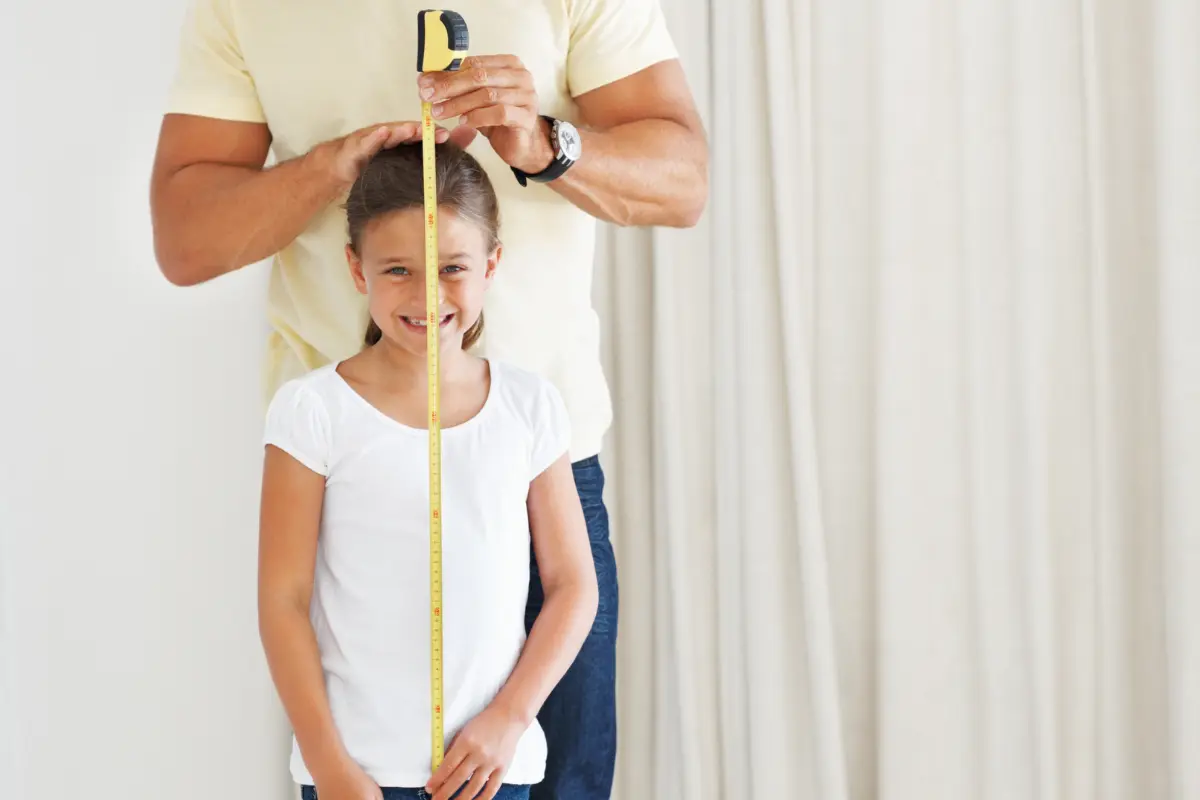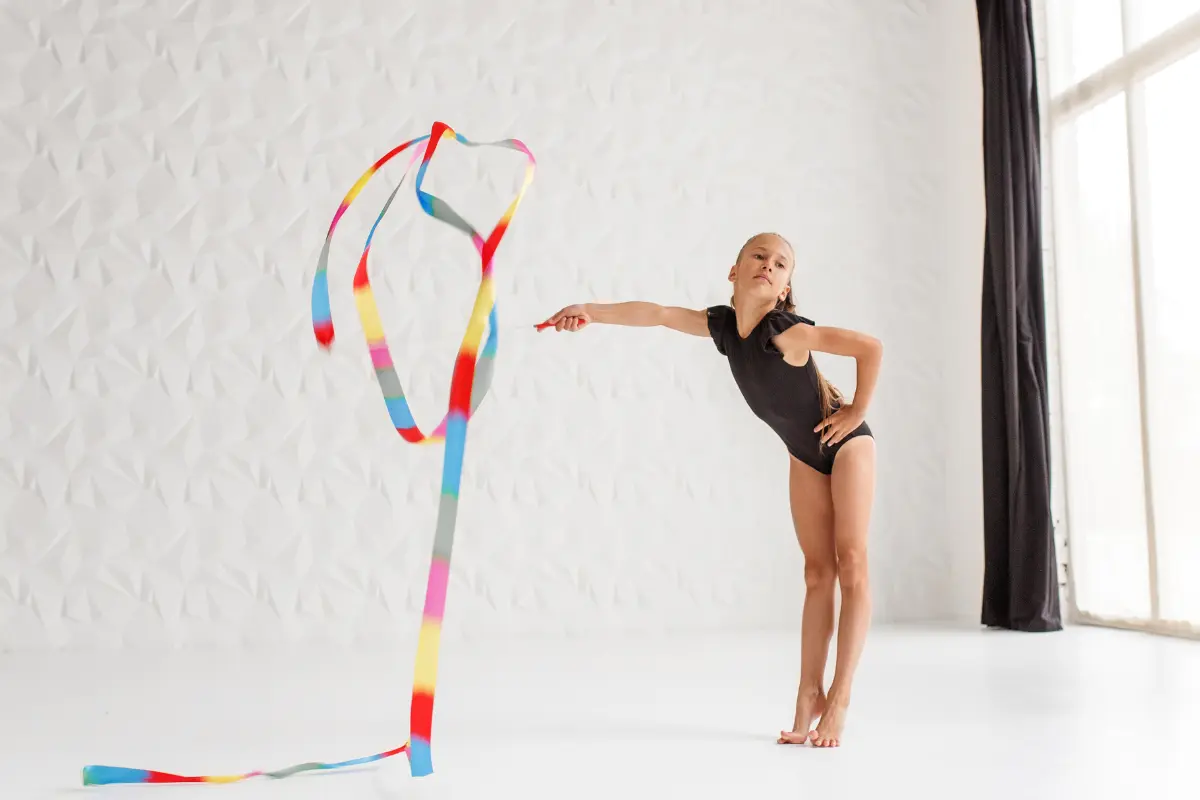The 2021–2029 Women’s Development Program Compulsory Cycle brings a fresh approach to early-level gymnastics. These routines—Levels 1 through 5—emphasize clean shaping, safe progression, and smooth transitions into optional gymnastics. From the first stretch jump to the first back tuck dismount, every level builds thoughtfully on the last.
All compulsory routines start from a 10.0, except Level 5 bars, which allows a downgraded dismount for a 9.5 start value. Each level refines form, strength, and artistry—layer by layer.
Summary Table of Skills (2021–2029)
A quick overview of what each level introduces, across all apparatuses:
| Level | Vault | Uneven Bars | Balance Beam | Floor Exercise |
|---|---|---|---|---|
| Level 1 | Stretch jump to handstand on 16″ mat stack, fall to straight hollow | Pullover, cast, back hip circle, underswing/sole-circle dismount | Needle kick, relevé-lock stand, 30° arabesque, cartwheel to ¾ handstand dismount | Forward/backward rolls, candlestick, ¾ handstand, cartwheel, pivot turn, pose |
| Level 2 | Handstand flat-back vault over mat stack | Glide swing, pullover, cast, back hip circle, underswing dismount | Pivot turn, stretch jump, cartwheel ¼ turn dismount | Held handstand, cartwheel, backward roll to push-up, bridge kickover, leap (60°), ½ turn |
| Level 3 | Front handspring over resi-mat (sideways) | Glide pullover or kip, cast, hip circles, squat-on, stretch jump dismount | Vertical handstand, 90° leap, straight jump, pivot, cartwheel dismount | Split jump (90°), handstand forward roll, bridge kickover, BWR to handstand, RO + BH |
| Level 4 | Front handspring over vault table | Glide kip, cast to horizontal, squat-on/sole-circle, long hang kip, flyaway dismount | Cartwheel, 120° leap, handstand hold, split jump, squat turn, side handstand dismount | Straddle jump (120°), FHS step-out, BWR, back walkover, RO + 2 BH |
| Level 5 | Front handspring over vault table (higher expectations) | Kip, cast above horizontal, clear hip (or alternative), long hang kip, flyaway (optional downgrade to 9.5 SV) | Acro skill (choice), 150° leap, split jump–sissonné, full turn, cartwheel, back tuck dismount | Straddle + stretch jump full, FHS step-out, BWR, front tuck/aerial, RO + BH + BT |
Level 1 – Foundation & Form
Level 1 is taught inside the gym, not at formal competitions. It’s all about movement quality and learning how to think and move like a gymnast.
Vault
A short sprint, a stretch jump onto a 16″ mat stack, and a vertical handstand that flows into a straight-hollow fall to the back. This vault teaches shoulder block, straight-line posture, and body tension. Arms must stay by the ears, and the fall should never break the hollow shape.
Uneven Bars
A simple but crucial sequence: pullover → cast → back hip circle → sole-circle or underswing dismount. A squat-on or pike-on introduces bar transitions. Skipping the cast or touching the high bar during dismount prep earns big deductions. Each skill builds rhythm, bar tension, and shaping.
Balance Beam
Beam starts with artistry. From front support to a needle-kick rise, the gymnast shows a relevé “lock” stand, a crisp 30° arabesque, and a cartwheel into a ¾ handstand dismount. These early skills develop balance, poise, and alignment.
Floor Exercise
Think shapes before saltos: forward roll, backward roll, candlestick, and a cartwheel, all linked with early dance and a pivot turn. This routine introduces performance to music and separates flexed-foot errors from bigger posture problems.
Refinements at Level 1
- Relevé “lock” replaces flat-footed balance.
- Handstands must show straighter body lines.
- Coaches evaluate 4 key criteria per event—3 must be met to pass.
Level 2 – Bridges to Basic Power
Level 2 builds on Level 1’s foundation and begins to add strength, power, and flexibility. It’s often treated as a checkpoint before competing.
Vault
The gymnast now kicks to a vertical handstand on a mat stack and falls flat-back. Unlike Level 1, the handstand must be momentarily vertical, and tight hollow posture is expected throughout.
Uneven Bars
Glide swing into pullover, cast, back hip circle, and underswing dismount. The glide swing adds momentum control, while core tension and hand placement matter more than ever.
Balance Beam
The gymnast performs a pivot turn, stretch jump, and a cartwheel ¼ turn dismount. These skills challenge balance and coordination in a narrower space while encouraging connection between elements.
Floor Exercise
The first bridge kickover appears, along with a held handstand, backward roll to push-up, split leap to 60°, and a heel-snap ½ turn. These skills build flexibility, mobility, and early acro strength.
Refinements at Level 2
- Leap angles raised to 60° minimum.
- Bridge kickover encourages shoulder flexibility.
- Evaluation focuses on linking positions with control.
Level 3 – First Handspring & Flight
Level 3 wraps up the non-competitive ladder but is often used in local meets. It introduces gymnasts to real flight on vault and floor.
Vault
A front handspring over a sideways resi mat teaches gymnasts to push off the hands and rotate over the top. The form must be clean, the body tight, and the landing controlled.
Uneven Bars
Gymnasts may choose a glide pullover or kip. Casts, both hip circles, a squat-on or pike-on, and a stretch jump dismount follow. This sequence supports kipping progression while rewarding body control and swing rhythm.
Balance Beam
Now includes a vertical handstand, a 90° split leap, a straight jump, pivot turn, and cartwheel to ¼ turn dismount. Holding the handstand and connecting movements cleanly is key.
Floor Exercise
This is the first level to include airborne tumbling: a round-off back handspring. Also featured: a split jump, handstand-forward roll, bridge kickover, backward roll to handstand, and leap + turn.
Refinements at Level 3
- Handspring vault replaces handstand-fall drills.
- First true flight on floor with back handspring.
- Beam handstand must hold vertical, not just reach it.
Level 4 – First National Competitive Level
This is the first compulsory level with a required mobility score (34.00 AA). Skills now look more advanced, and judges raise the bar on form, amplitude, and connection.
Vault
A front handspring over the vault table. Focus is on rise, repulsion, heel drive, and a strong two-foot landing.
Uneven Bars
Glide kip, cast to horizontal, squat-on or sole circle, long hang kip, back hip circle, and tap swing ½-turn flyaway. This routine links swing, shaping, and a controlled flyaway dismount.
Balance Beam
Cartwheel, 120° split leap, handstand (2-second hold), split jump, 180° squat turn, full passé turn, and side handstand dismount. Execution is key—each element must show rhythm, amplitude, and artistry.
Floor Exercise
Straddle jump to 120°, front handspring step-out, back extension roll, back walkover, straight jump ½, leap, full turn, and round-off + two back handsprings. Dance elements must show flexibility, and tumbling passes must connect tightly.
Refinements at Level 4
- Beam squat turn replaces outdated leg-swing pivot.
- Stricter standards for leap and turn positions.
- Two-skill tumbling passes now emphasized.
Level 5 – Last Stop Before Optionals
Level 5 introduces acro choices and salto dismounts. It’s the final step before optional routines, and expectations are higher than ever.
Vault
Same as Level 4—a front handspring over the vault table—but with more scrutiny on block, posture, and body position.
Uneven Bars
Kip, cast above horizontal, clear hip (or alternative to clear support), squat-on, long hang kip + pullover, and a flyaway.
📌 Optional downgrade: a Level 4 flyaway may be used for a 9.5 start value to delay riskier swing flyaways.
Balance Beam
Athletes choose one of four acro elements (e.g., back walkover, front walkover, back handspring, or back extension roll). Then: a 150° split leap, split jump–sissonné, full turn, cartwheel, and a back tuck dismount. The beam dismount marks the gymnast’s first salto on beam.
Floor Exercise
Straddle jump + stretch jump with full turn, front handspring step-out, back extension roll, ¾ hop turn, front tuck or aerial option, 150° split leap, full turn, and a round-off + back handspring + back tuck. This routine demands both tumbling power and expressive dance presentation.
Refinements at Level 5
- Leap angles raised to 150°.
- Beam acro is now customizable.
- Optional dismount choices on bars give flexibility for readiness and safety.
Bottom line
Mastery of these updated compulsory skills is the surest way to build a long, safe, and successful optional career. All skill descriptions, routine elements, and progression guidelines are based on the official USA Gymnastics publication:
👉 2021–2029 USAG Women’s Development Program Compulsory Book (PDF)
This document provides the complete and authoritative guide to routines, evaluation points, and judging criteria for Levels 1–5 in the current compulsory cycle.



